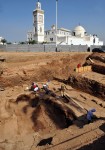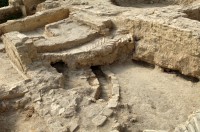 Construction of a new subway line and station in Algiers has revealed archaeological remains dating from Roman times through the French colonial period. Remains were first discovered in 2009 during archaeological surveys along the proposed subway line. The full excavation began in 2013, recovering archaeological materials going back to the 1st century B.C.
Construction of a new subway line and station in Algiers has revealed archaeological remains dating from Roman times through the French colonial period. Remains were first discovered in 2009 during archaeological surveys along the proposed subway line. The full excavation began in 2013, recovering archaeological materials going back to the 1st century B.C.
The site is in the historic Casbah area of Algiers which was founded in the 3rd century B.C. by Punic Phoenicians as a small trading post. It became a Roman colony in 146 B.C. after the fall of Carthage, and its name was Latinized from Yksm (“Island of the Seagulls”) to Icosium. Icosium became part of the Roman client state of Mauretania in the late 1st century B.C., which became a Roman province under Caligula in 40 A.D. Mauretania was divided into two provinces, Mauretania Tingitana and Mauretania Caesariensis, the latter of which included Icosium.
 During the chaotic decades of imperial musical chairs, barbarian invasions, epidemics and economic woes that became known as the Crisis of the Third Century, Berber tribes made incursions into what is now Algeria, contracting the areas of Roman control. A fortified city on the sea, Icosium held out a long time, but was sacked in 371 A.D. by the Berber Prince Firmus during his revolt against Romanus, the military commander of Rome’s Africa Province. Icosium never recovered and disappeared from the historical record in the 5th century.
During the chaotic decades of imperial musical chairs, barbarian invasions, epidemics and economic woes that became known as the Crisis of the Third Century, Berber tribes made incursions into what is now Algeria, contracting the areas of Roman control. A fortified city on the sea, Icosium held out a long time, but was sacked in 371 A.D. by the Berber Prince Firmus during his revolt against Romanus, the military commander of Rome’s Africa Province. Icosium never recovered and disappeared from the historical record in the 5th century.
The city of Algiers was founded by Berbers in the mid-10th century. The Casbah, a fortified citadel common in North African cities, was built over what had once been Icosium on the cliffs overlooking the sea. In the late 15th century Algiers was conquered by Spain, but their occupation would not last. The Ottoman admiral Hayreddin Barbarossa tossed the Spanish out permanently in 1525 and established Algiers as the capital of an Ottoman regency which would become the empire’s primary base in the region. The Ottoman Regency of Algiers lasted until the French took the city in 1830.
 The French pillaged Algiers, destroying religious sites like the Es Sayida mosque in the Casbah. Between the French and the long line of conquerors that preceded them, it didn’t seem likely that there would be much of Algiers’ history left to find below the surface. Nobody imagined they’d unearth such a wealth of archaeological materials, even from the long gap between the fall of Icosium and the rise of Berber Algiers.
The French pillaged Algiers, destroying religious sites like the Es Sayida mosque in the Casbah. Between the French and the long line of conquerors that preceded them, it didn’t seem likely that there would be much of Algiers’ history left to find below the surface. Nobody imagined they’d unearth such a wealth of archaeological materials, even from the long gap between the fall of Icosium and the rise of Berber Algiers.
Finds over the 3,000 square meters (32,300 square feet) of the excavation site include a public building with mosaic flooring dating to the 5th century, a 7th century Byzantine necropolis with dozens of graves, large numbers of Roman-era architectural elements — columns, capitals, pediments — ancient catapult balls and 385 coins. The excavation even found parts of the Es Sayida mosque, a thoroughly unexpected survival given that the French colonial government built a square over the levelled mosque and named it King’s Square, renamed Martyrs Square after Algeria won its independence in 1962.
 Algeria has some of the most significant Roman architecture still standing in the world, but none of it is in Algiers. That makes the metro ruins exceptionally important, so much so that the city completely changed its plans for the line and station. The Martyrs Square subway station, originally planned to be 8,000 square meters in area, will now take up only 3,250 square meters and will have a museum built into it. The train line is going way underground, as much as 115 feet deep, to avoid interfering with the ancient remains.
Algeria has some of the most significant Roman architecture still standing in the world, but none of it is in Algiers. That makes the metro ruins exceptionally important, so much so that the city completely changed its plans for the line and station. The Martyrs Square subway station, originally planned to be 8,000 square meters in area, will now take up only 3,250 square meters and will have a museum built into it. The train line is going way underground, as much as 115 feet deep, to avoid interfering with the ancient remains.
The Martyrs Square station is set to open in November, part of an extension to the main metro line inaugurated in October 2011.
The museum will open shortly afterwards, covering 1,200 square metres and organised chronologically.
Some of the remains will be exposed to a depth of over seven metres.
“In Rome or Athens, museums present particular periods, whereas here the visitor can embrace the whole history of Algiers over 2,000 years,” [archaeologist and excavation co-director Kamel] Stiti said.